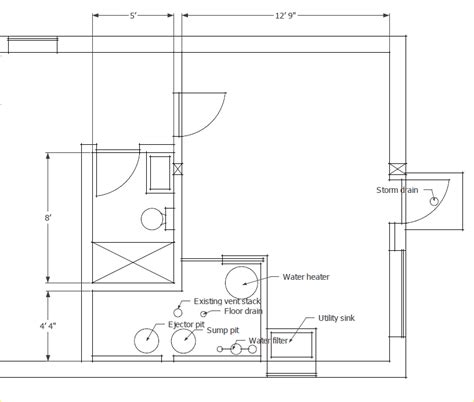How Big Does A Mechanical Room Need To Be
Ronan Farrow
Apr 03, 2025 · 3 min read

Table of Contents
How Big Does a Mechanical Room Need To Be? A Comprehensive Guide
Determining the appropriate size for a mechanical room is crucial for efficient building operation and compliance with relevant codes. It's not a one-size-fits-all answer; the necessary space depends significantly on several factors. This guide breaks down the key considerations to help you determine the right mechanical room size for your project.
Factors Affecting Mechanical Room Size
Several key factors influence the minimum size requirements for your mechanical room:
1. Equipment Size and Type
This is arguably the most important factor. The sheer size of the equipment you intend to house will dictate a significant portion of the required space. Consider:
- Boilers: Large boilers require substantial floor space, plus additional room for maintenance access and maneuvering.
- Chillers: Similar to boilers, chillers come in various sizes, demanding appropriate space for their footprint and service access.
- HVAC Units: The size and number of HVAC units (air handling units, pumps, etc.) will directly influence the overall area needed. Remember to account for ductwork and piping connections.
- Water Heaters: The capacity of water heaters impacts their dimensions. Larger commercial units will need more space.
- Electrical Panels and Transformers: These are essential but often overlooked. Ensure adequate space for safe access and maintenance.
2. Access and Maneuverability
Sufficient space must be allocated for easy access to all equipment for maintenance and repairs. This includes:
- Clearance around equipment: Allow ample space for technicians to work comfortably around each piece of equipment.
- Walkways and aisles: Designate clear walkways for safe movement within the room.
- Doors and entryways: Ensure doors and entryways are wide enough to accommodate the largest piece of equipment that might need to be replaced or serviced. Consider the possibility of needing to bring in large cranes or forklifts.
3. Codes and Regulations
Local building codes and regulations will mandate minimum space requirements for mechanical rooms. These codes often specify:
- Minimum ceiling height: Sufficient clearance is necessary for ventilation and maintenance.
- Fire safety requirements: Codes often stipulate specific fire suppression systems and their placement, impacting the layout and size.
- Accessibility standards: Mechanical rooms must adhere to ADA (Americans with Disabilities Act) or equivalent accessibility guidelines for appropriate walkways and clearances.
4. Future Expansion
Always consider future expansion when planning your mechanical room. Allow for extra space to accommodate potential growth or upgrades to your building's systems. Overestimating slightly is better than having to make expensive alterations later.
Calculating the Required Space: A Step-by-Step Approach
- List all equipment: Create a comprehensive list of every piece of mechanical equipment you plan to install.
- Determine dimensions: Obtain the exact dimensions (length, width, and height) of each piece of equipment from manufacturer specifications.
- Account for clearance: Add extra space around each piece of equipment to allow for maintenance access and maneuverability (typically 3-4 feet on each side).
- Plan walkways and aisles: Designate space for clear walkways and aisles, ensuring easy navigation.
- Check local codes: Consult with local authorities to verify compliance with all relevant building codes and regulations.
- Factor in future growth: Add extra space to accommodate potential future expansion.
- Total the area: Sum up the total area required for equipment, clearance, walkways, and future expansion to determine the minimum mechanical room size.
Conclusion
Designing the right size mechanical room requires careful planning and consideration of multiple factors. By meticulously assessing equipment needs, accessibility requirements, codes, and future expansion potential, you can ensure that your mechanical room is adequately sized for efficient and safe operation. Remember to consult with experienced professionals to guarantee compliance and optimize space utilization.
Featured Posts
Also read the following articles
| Article Title | Date |
|---|---|
| Determine How A Router Makes A Forwarding Decision By Default | Apr 03, 2025 |
| How To Unlock Pcm | Apr 03, 2025 |
| How Big Is 27 Oz Perfume | Apr 03, 2025 |
| How Accurate Are Forensic Interviews | Apr 03, 2025 |
| How To Use Bubble Bags | Apr 03, 2025 |
Latest Posts
-
How Hard Is The Lsat Compared To The Mcat
Apr 04, 2025
-
How Hard Is The Florida General Contractor Test
Apr 04, 2025
-
How Hard Is It To Rebuild A Th350 Transmission
Apr 04, 2025
-
How Hard Is It To Prove Medical Malpractice
Apr 04, 2025
-
How Hard Is It To Play Bass
Apr 04, 2025
Thank you for visiting our website which covers about How Big Does A Mechanical Room Need To Be . We hope the information provided has been useful to you. Feel free to contact us if you have any questions or need further assistance. See you next time and don't miss to bookmark.
